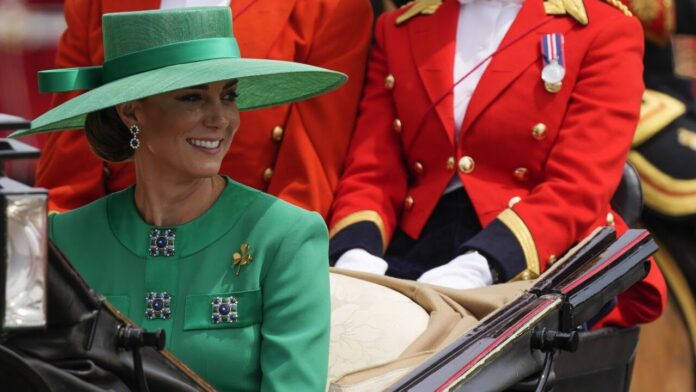Prince William and Princess Kate’s children stole the show with candid reactions and playful antics during the parade
Last year’s Trooping the Colour ceremony featured several moments the Royal Family likely preferred to keep under wraps. Prince William and Princess Kate’s children—Prince George, Princess Charlotte, and Prince Louis—captured the spotlight with their candid reactions and playful antics. Although the military commemoration proceeded smoothly, the young royals’ behaviour during the parade from Buckingham Palace to Whitehall became the day’s main focus. Their appearance on the palace balcony for the military flyover also provided memorable moments.
Prince Louis, known for his expressive reactions, especially grabbed attention. He was seen pulling faces and playing up to the camera. A particularly memorable moment occurred when he cupped his nose and grimaced during a ride through the Mall, likely due to the strong smell of horse manure. His brother George also showed discomfort, wrinkling his nose in response.
A body language expert told the Daily Star that the young royals seemed visibly disturbed by the unpleasant smell, with both George and Louis showing clear signs of discomfort. Despite the formal occasion, these candid moments offered a humorous glimpse into the lives of the royal children.
Prince Louis’s antics continued to charm royal fans. His signature “window wiper” wave during a balcony appearance delighted onlookers and social media users. Despite a spectacular flyover of 70 aircraft at the end of the service, it was Louis who captured everyone’s attention with his adorable gesture. One fan tweeted, “Prince Louis and his unique wiper blade wave.”
Prince Louis consistently impresses during balcony appearances, though some fans noted he appeared slightly “bored” during his last outing at King Charles’ Coronation. Princess Charlotte also caught attention, looking “impatient” during a conversation with her great-aunt, the Duchess of Edinburgh. Lip reader Jeremy Freeman suggested the young princess was asking how long the event would last, reminiscent of King Charles’ own impatience at his Coronation.
Charlotte drew comparisons to her late grandmother, Princess Diana, with fans noting her “distinctive stride.” One Twitter user commented, “Does Princess Charlotte’s stride here remind you of the way Princess Diana used to walk? I thought of Diana immediately.”
In a candid moment, Kate Middleton was seen giving a stern “telling off” to the young royals on their way to Buckingham Palace. Lip reader Jeremy Freeman claims that the Princess of Wales told them, “Do not look behind whilst on the coach.” Despite this, Princess Charlotte was spotted looking back after the warning was allegedly given.
King Charles III marked his honorary birthday just before Trooping the Colour, a tradition dating back to King George II. The event is not just a continuation of a long-standing tradition of summer festivities, but also a tribute to his late mother, Queen Elizabeth II. Queen Elizabeth II had chosen the second Thursday of June for a sunnier celebration, and King Charles III has embraced this tradition, linking his official birthday with the Trooping the Colour event.
In-depth Analysis
The Trooping the Colour ceremony serves as a rich source of analysis from multiple perspectives. This year’s event highlighted the intersection of tradition and modernity within the royal family.
Politically, the ceremony underscores the monarchy’s role in maintaining British heritage. Trooping the Colour has long been a symbol of royal continuity and national pride. However, the candid behaviour of the young royals during the event brought a humanizing element to the otherwise formal and regimented proceedings, showing a blend of tradition with contemporary familial dynamics.
Sociologically, the event showcased the evolving image of the royal family. The visibility of the young royals and their candid moments resonate with a public that increasingly values authenticity over strict adherence to protocol. These moments of spontaneity can make the royal family appear more relatable and accessible to the general populace.
Economically, the event’s global media coverage and public interest generate significant attention and tourism revenue for the UK. The royal family’s ability to capture the public’s imagination, even through informal and unscripted moments, contributes to their enduring appeal and economic impact.
From a local perspective, the Trooping the Colour ceremony fosters national unity and pride. It brings together citizens and visitors to celebrate the British monarchy, while also providing a platform for the display of military precision and pageantry, reinforcing a sense of national identity and continuity.
From a gender perspective, the roles and visibility of the young royals, particularly Princess Charlotte, highlight the changing dynamics within the royal family. Charlotte’s presence and actions, compared to her brothers, reflect evolving gender norms and expectations within the institution. Her comparisons to Princess Diana also evoke a sense of continuity and legacy within the royal lineage.
Analyzing the event from the perspective of race and minority representation, the candid moments of the young royals offer a more inclusive and relatable image of the monarchy. While the royal family has faced criticism for its handling of issues related to race and diversity, the visibility of its younger members and their unfiltered behaviour can help bridge gaps and foster a more inclusive perception of the institution.
The Trooping the Colour ceremony offers a multifaceted look at the British monarchy, blending tradition with modernity, and highlighting the evolving dynamics within the royal family. The candid moments of the young royals not only provide entertainment but also offer insights into the intersection of tradition, authenticity, and relatability in the contemporary monarchy.
